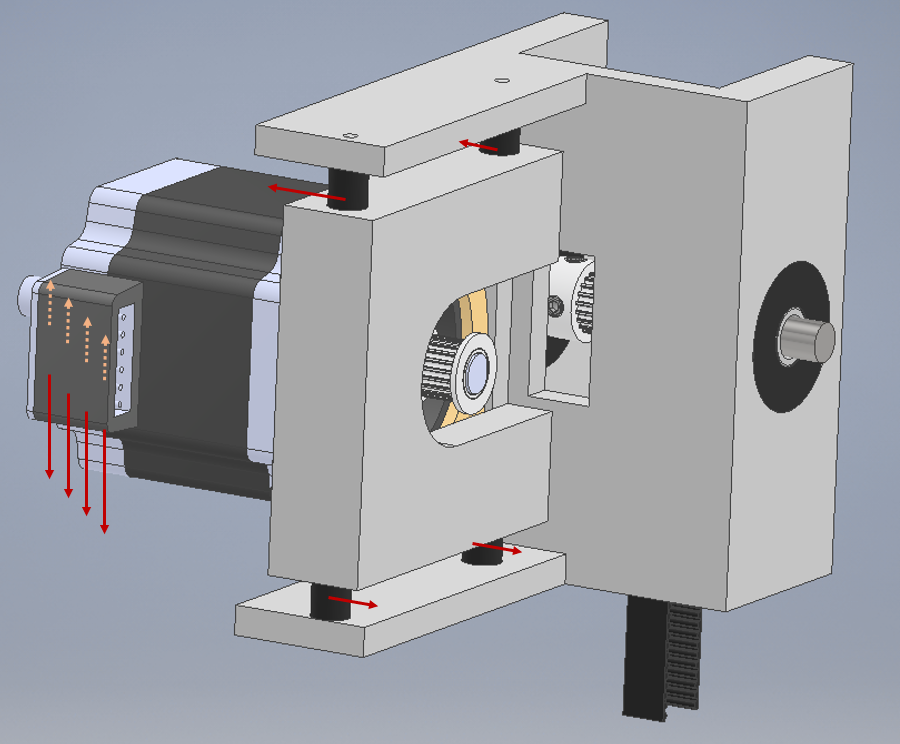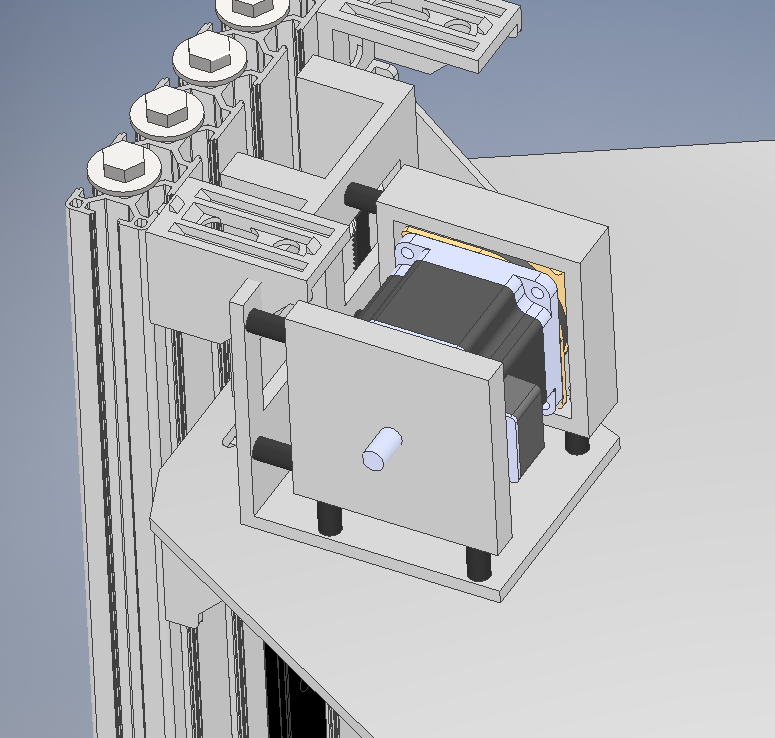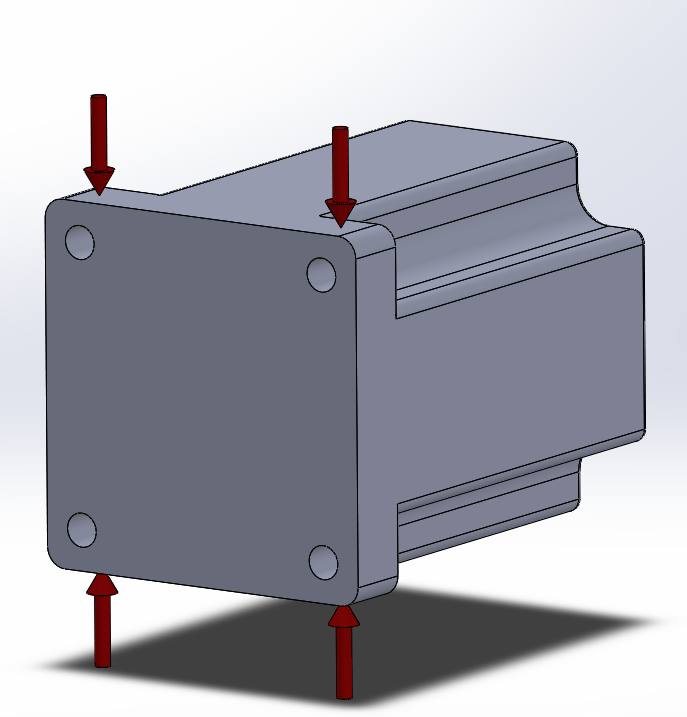Battling sources of vibration and noise
-
@Nxt-1 IMO, the shown configuration, the top, and bottom mounts will have constant shear stress, which will lessen their effectiveness and in this case, might cause more vibrations to resonate as the back end of the motor is unrestrained, and will shorten the lifespan. I would move the two mounts from the top to the rear-bottom of the motor. Of course, the hardness of these mounts is unknown to me, but this is just general.
Also, with the configuration, it gives you the advantage to easily change the drive ratio. If more vibration/noise is experienced at slow stepper motor speeds and lessens at higher speeds, you could change the drive ratio which could reduce the over/undershooting from the driver-motor arrangement.

-
@Nxt-1, I think you're using f360? I am no expert in f360 but you could try to perform a stress analysis of the part.
https://www.youtube.com/watch?v=LBZAH5RMR2c -
@Nxt-1 On changing the drive ratios, you could leave the ratio the same, but still change some of the pulley teeth numbers. I'm thinking keep the motor pulley the same, but go up a size or two on both pulleys on your idler shaft (and the one at the bottom of your tower). My understanding is that larger pulleys operate more smoothly as the belt is pulled round such a tight radius.
It might also help distrupt any belt meshing interactions that might be causing your NVH issues? I'm particularly thinking of your findings with the idelr at the bottom of the tower.On a different note (and sorry if I'm digging up old ground here...), I read another post recently where DC42 mentioned that Nema23 motors are typically more susceptible to noise issues than Nema17's. I think you'd previously mentioned that you didn't want to go back to smaller steppers, so not sure how useful it is, but I thought intersting to know
@dc42 said in Massive Vibrations with Duet3 & NEMA23 drives:
What I think I said, which was based on something I had read elsewhere, was that when designing a stepper motor there is a balance to be had between smoothness of microstepping (i.e. how consistent the size of each microstep is) and torque; and that Nema 17 motors were typically designed to favour smooth microstepping, whereas Nema 23 motors were typically designed to favour maximum torque.
All stepper motors suffer from mid-band resonance, which is caused by the inherent elasticity of the magnetic forces combined with the rotor inertia. However, mid-band resonance tends to occur at travel speeds, not printing speeds.
-
@engikeneer said in Battling sources of vibration and noise:
as the belt is pulled round such a tight radius.
yes, larger pulleys for the win, they prolong the life of the belt, dunno if they affect anything else but I for sure go with 5cm radius min for those belts ... it's min allowed for steel 5mm pitch belts so I use that radius for 2mm pitch too if I can / when I can
-
@Kolbi I don't see where the downwards forces would come from, as the forces due to belt tension would be rotated 90° (so horizontal) That said I did drop the top dampers and looked into supporting the back side as well and for now I don't have room. I certainly could do some shuffling around to make it fit, but for now I think I will test a front face only mount and see how it works out.

@the video from Oriental, yes I have seen that. Yet I cant really increase my steps per mm as that would increase the motor speed (which is the goal ofc) and thus increase the voltage due to back emf generated by the motor. And I already am at the upper limit of what I can handle with 24V Vin.
@Kolbi I am using Inventor, but that has very similar simulation tools AFAIK. Have not played with them before though, maybe I should.
@engikeneer and @arhi I already ordered and received 20T pulleys, the same as I already had a few. I'll keep the larger pulley sizes in mind for possible future revisions.
-
@Nxt-1 said in Battling sources of vibration and noise:
already ordered and received 20T pulleys, the same as I already had a few. I'll keep the larger pulley sizes in mind for possible future revisions.
I use big ones for the sake of belt longevity, no clue if they reduce noise, and I don't see why they would reduce noise .. now as already mentioned using 2 different size pulleys is an interesting prospect in increasing speed or precision
-
@Nxt-1, the downwards force would be from the motor's weight. Next time you pull one of the motors out, try to suspend it, with fingers at the arrow points shown below. But this is not a concern in your latest revision as the motor is supported at both ends. With this design, I would add a third damper mounting at the center position (between the two existing) on both, bottom and side mounting planes. This would give you some ability to experiment whereas maybe just one (centerline), or two (end-points), or all three dampers employed on the end/centerline would be best or for the bottom or side mount.

-
Over Friday and Saturday I designed, printed and tested some revisions and I don't think it's going to work out.
The first version looked very similar to the pictures I already posted here, but with just the front support (on the bottom and side). This was not really any better than the previous style brackets. The whole top bracket still resonated and noise was not really any better. During testing I also noticed I have made a minor error, resulting in a belt that was to right and pulling the motor to the side. It also seemed like the little rollers in the needle bearing were resonating.
To verify the bearing issue, I redesigned the bracket to accept 608 bearings instead. Testing showed no audible change in vibration levels. Test belt tension was also corrected, so the motor sits just about perfectly straight. While this version was printing I did design a version with 2 back support dampers, but ended up not printing it as it this style of bracket seems not they way to go and the motor sat level anyway.
To verify one more thing I removed the belt and did the same arc move that I have been using to test for a while now. And it was noticeably better. So what I feared seems true, the belt itself is poor vibration isolator. In fact the belt seems like the only real path the vibrations can couple into the rest of the machine.


-
At this moment I am debating whether to take the money dive and have the old style brackets cnc machined out of steel (weerg.com has a promotion that makes the steel options cheaper than alu at the moment
 )
)A user on the reprap forums reported that improved noise vibration issue he had with his nema23's (link to the post). It could make sense from a rigidity standpoint as well as the added mass, more mass is normally less vibrations right. Yet then again all the previous things I tried made sense too, and they didn't cost €360 to 'try out'.

-
@Nxt-1 if it is definitely the belt thats causing the resonance issues, I'd focus my efforts on that. Did you try the 20T pulleys? What about making a significant change to the belt length (longer or shorter)? Granted this might be tricky given the machine design... have you also tried using 9mm or 12mm belts instead? They'll at least have different mass/stiffness properties.
-
@engikeneer said in Battling sources of vibration and noise:
@Nxt-1 if it is definitely the belt thats causing the resonance issues, I'd focus my efforts on that. Did you try the 20T pulleys? What about making a significant change to the belt length (longer or shorter)? Granted this might be tricky given the machine design... have you also tried using 9mm or 12mm belts instead? They'll at least have different mass/stiffness properties.
I should have explained it better, I don't believe belts are causing resonance issues, the belts simply allow the vibrations to travel from the motor to the other parts of the machine instead of staying isolated to just the motor vibrating. If the belts themselves were sources of vibration you'd expect the frequency of the noise to change with varying belt tensions or lengths, which is is the opposite of what I am observing.
Just as an fyi, I am using 9mm proper gates belts on 20T pulleys
-
@Nxt-1 What is the loading range of the mounts you are using in the pic? IMO they seem way too rigid - they do not yield enough elasticity to absorb the vibration energy for this application. That is if the vibration energy is emitting from the motor itself.
-
@Kolbi said in Battling sources of vibration and noise:
@Nxt-1 What is the loading range of the mounts you are using in the pic? IMO they seem way too rigid - they do not yield enough elasticity to absorb the vibration energy for this application. That is if the vibration energy is emitting from the motor itself.
Sadly hard to say, I picked them up from a local hardware store and they were specified as 'damper, type B', no more no less. I agree, due to the compact size the isn't really that much room for flexing rubber, so they are stiffer than I'd have wanted. On the other hand, from my test without the belt, I can conclude they do their job. Otherwise the vibrations would still travel trough the rubber into the frame, which wasn't the case.
-
Finally some good news!

Yesterday evening I decided to try the inertial damper route. Someone linked it before in this thread and it's basically a high rotational inertia disk that you bolt on the stepper shaft. The added inertia functions similar to a smoothing capacitor in electronics and smooths down the riple, in this case of the vibrations caused by the motor.
Because I didn't have the time (nor the budget to just try) to get the real stuff from Oriental, I designed a very simple DIY intermediate. With lead disks and a printer cover to keep them in place. While it certainly is DIY
 it provides a night and day difference. I will most likely order the proper ones this week.
it provides a night and day difference. I will most likely order the proper ones this week.

-
@Nxt-1 aren't those supposed to slip?
-
@arhi said in Battling sources of vibration and noise:
@Nxt-1 aren't those supposed to slip?
Examining what little documents I can find on the proper dampers that could very well be the case. And I see it making sense to smooth movement while continuously turning, yet not hindering acceleration/jerk.
I don't think that level of performance is going to happen with what I just build here though, it's either all slip or no slip

I just placed an order for 3 of the proper ones from Oriental so we'll find out more soon enough I guess

-
-
@Nxt-1 said in Battling sources of vibration and noise:
find out more soon enough
Hope it goes well, I was wondering how those would be in regards to acceleration and jerk.
-
@Nxt-1
I'm curious to see the numbers once you have three installed. I would expect that you can still get the motors to vibrate, but the dampers are probably shifting that frequency to a place you'll never get to...I'm also curious if they make a difference to print quality.
-
@Nxt-1, I just had an idea on determining your motor vibration emission, not sure on how effective though.
If you cut the current down by ~75% it should decrease the intensity of motor generated vibrations while the movement (drive train) generated vibrations would stay the same. This could let you know what to expect with the installation of the rotational dampers / help separate the two possible offending sources.